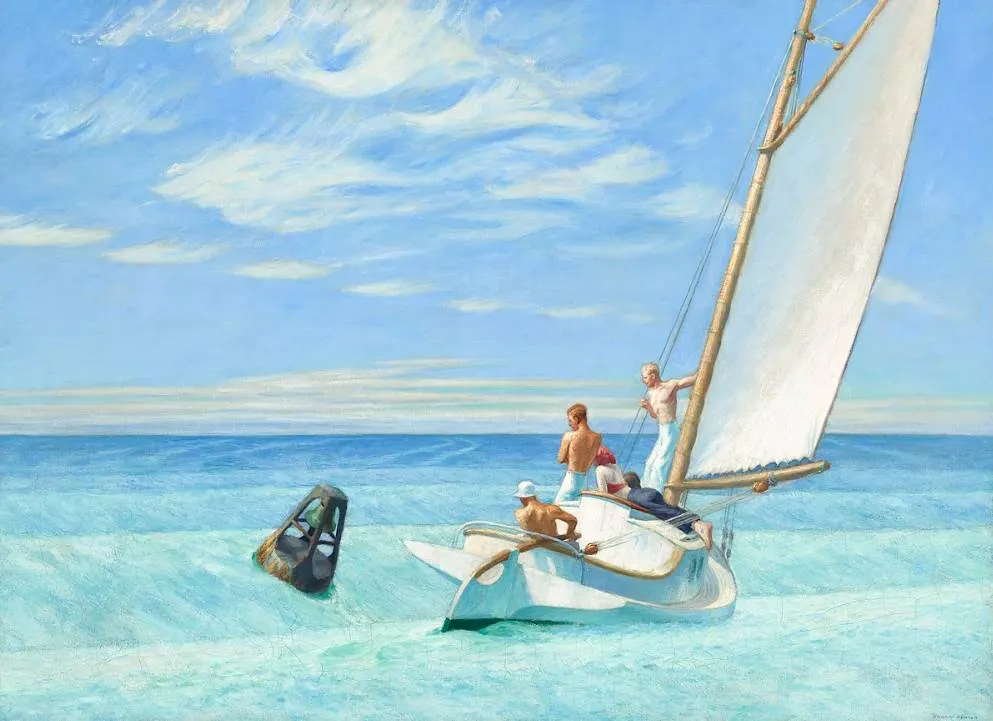One of the greatest American artists in history mainly focused on realistic depictions of common subjects. He did it, however, in a fantastic manner, unlike any other Realism artist.
Edward Hopper (1882-1967) was an aspiring artist in New York City in the early 20th century who had to work as an illustrator at an advertising company to support himself.
Saying that he didn’t enjoy this job is putting it euphemistically. When he didn’t find inspiration for oil paintings he turned to printmaking.
He became a successful etcher in the second decade but it wasn’t enough to result in his artistic breakthrough. This came when he remet his future wife Josephine Nivison (1883-1968) in 1923.
She was an artist herself with whom he had studied in his younger years. More importantly, she was sociable and had connections which resulted in the first exhibition of Hopper’s paintings in 1923 at the Brooklyn Museum.
In this article, we’ll take a closer look at some of the most famous paintings by Edward Hopper so you can learn all about this important figure in the history of American art.
1. Nighthawks
- Date created: 1942
- Dimensions: 84.1 × 152.4 centimeters (33.1 x 60 inches)
- Location: Art Institute of Chicago, Chicago, United States
Nighthawks is the title of the most famous painting by Edward Hopper. It depicts a downtown diner in a desolate urban landscape that is brightly illuminated. We can see 4 people inside through the large glass window that covers the length of the establishment.
It was completed when the American artist was already one of the most famous artists in the country. He managed to sell it to the Art Institute of Chicago for the handsome sum of $3,000 within months after it was completed. This was a great investment as it’s one of the most iconic paintings at this popular museum in Chicago today.
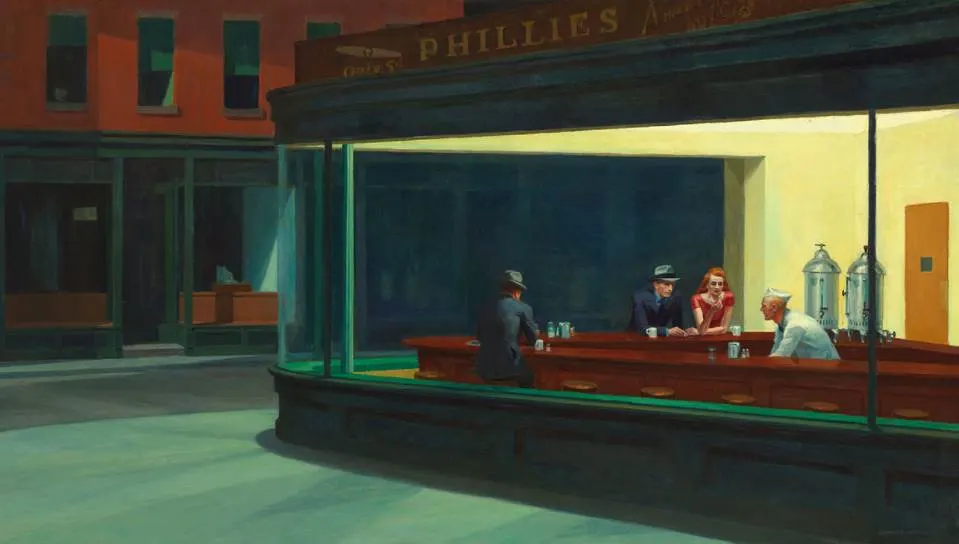
2. Automat
- Date created: 1927
- Dimensions: 71.4 × 91.4 centimeters (28 × 36 inches)
- Location: Des Moines Art Center, Des Moines, United States
Automat is a painting that depicts a woman sitting in an automated fast-food shop and having a cup of coffee. The painting is characterized by the unrealistic dark view outside of the window that reflects the lights inside the store. This view couldn’t have been possible in the bright illuminated streets of New York.

Loneliness was always an important subject in Hopper’s oeuvre and this painting is one of the best examples of that. The darkness of the window strengthens the notion that the girl is all alone. This painting was exhibited at the second solo exhibition of Hopper and sold for $1,200 less than 2 months after it was first exhibited.
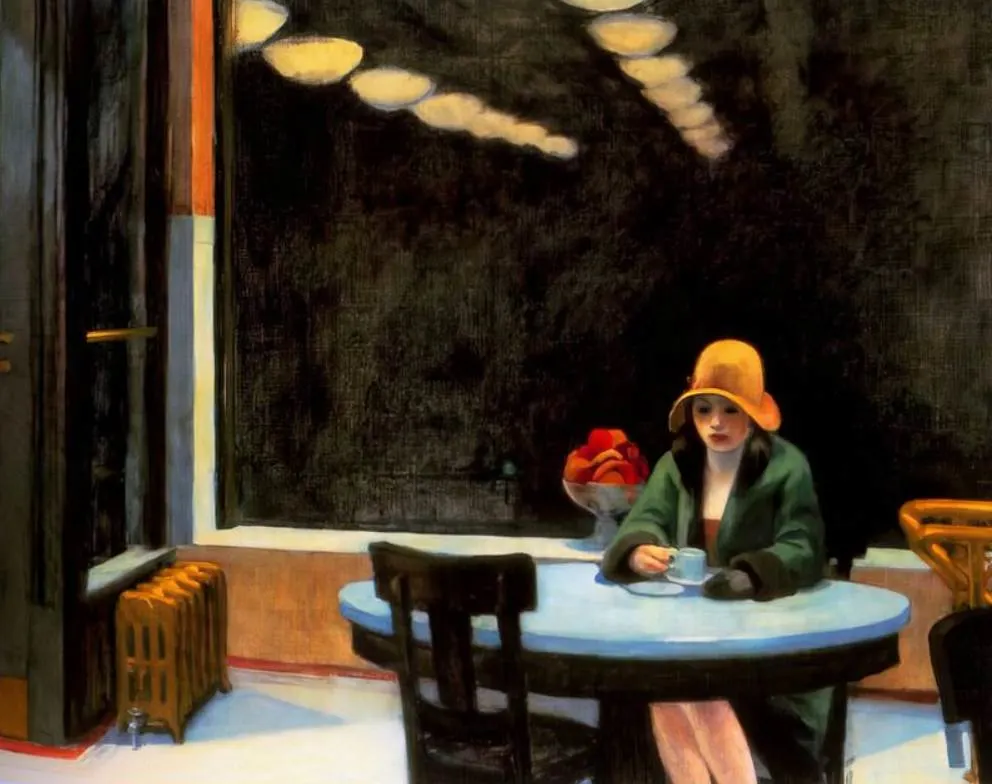
3. Chop Suey
- Date created: 1929
- Dimensions: 81.3 × 96.5 centimeters (32 x 38 inches)
- Location: Private Collection
Chop Suey is a painting that was completed shortly before the Wall Street Crash of 1929, an event that plunged the world into the Great Depression of the 1930s. It depicts two women who are having lunch in a restaurant in the foreground and a couple sitting at another table in the background.
It’s another painting that takes place in an indoor setting and which focuses on the isolation of people in society. While Hopper he was able to sell his paintings for the equivalent of $10,000s (with inflation in mind) during his career, it’s nothing compared to the $91.9 million paid for Chop Suey by a private collector in 2018.

4. House by the Railroad
- Date created: 1925
- Dimensions: 60.9 x 73.6 centimeters (24 x 29 inches)
- Location: MoMA, New York City, United States
House by the Railroad is another iconic and influential work in the history of American art. It was supposedly, just like most other Hopper paintings, inspired by a real house in Haverstraw, New York. This house constructed in a Second Empire architectural style during the Victorian era still stands there today.
Although the painting is a relatively simple composition with only a railroad in the foreground and the house directly behind it, it was highly influential in other forms of media. It was the inspiration for the Bates home in Alfred Hitchcock’s Psycho and the house of Charles Addams of the Addams Family.
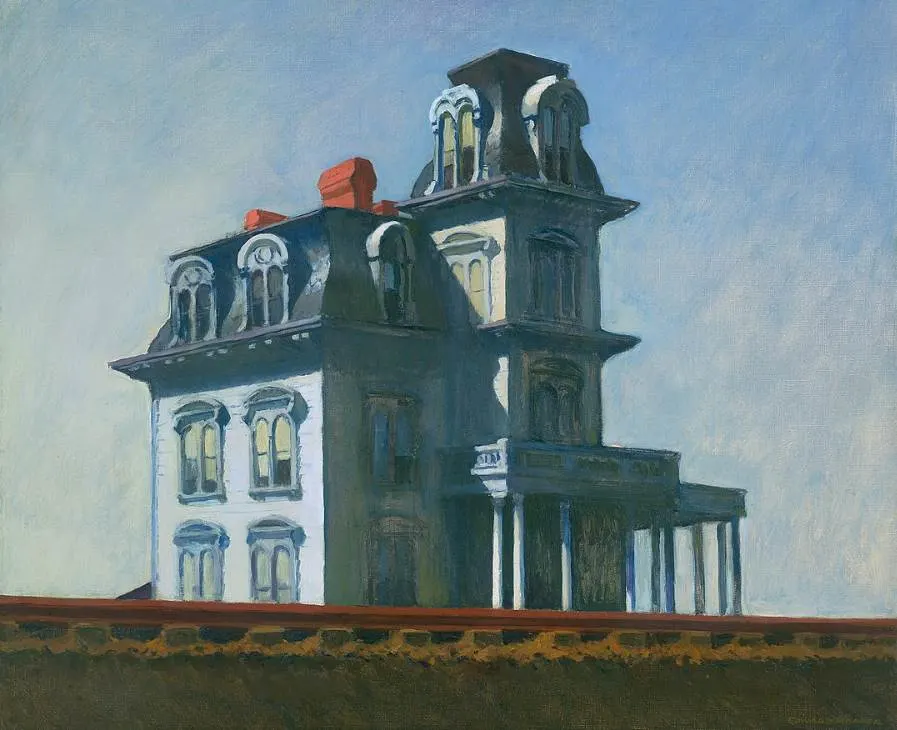
5. Office at Night
- Date created: 1940
- Dimensions: 56.4 × 63.8 centimeters (22.2 x 25.1 inches)
- Location: Walker Art Center, Minneapolis, United States
Office at Night is a painting that depicts an attractive young woman and a slightly older man in a small office. The scene is viewed from a slightly elevated position and was most probably inspired when the artist managed to look inside offices while riding the L-Train in New York City.
Hopper provides the viewer with several clues as to what happens. The wind from the passing train probably blew a piece of paper on the ground which is noticed by the woman. The wind also blows her tight dress to her legs which accentuates her voluptuous figure. This is one of several works by the artist which convey a veiled sense of eroticism.
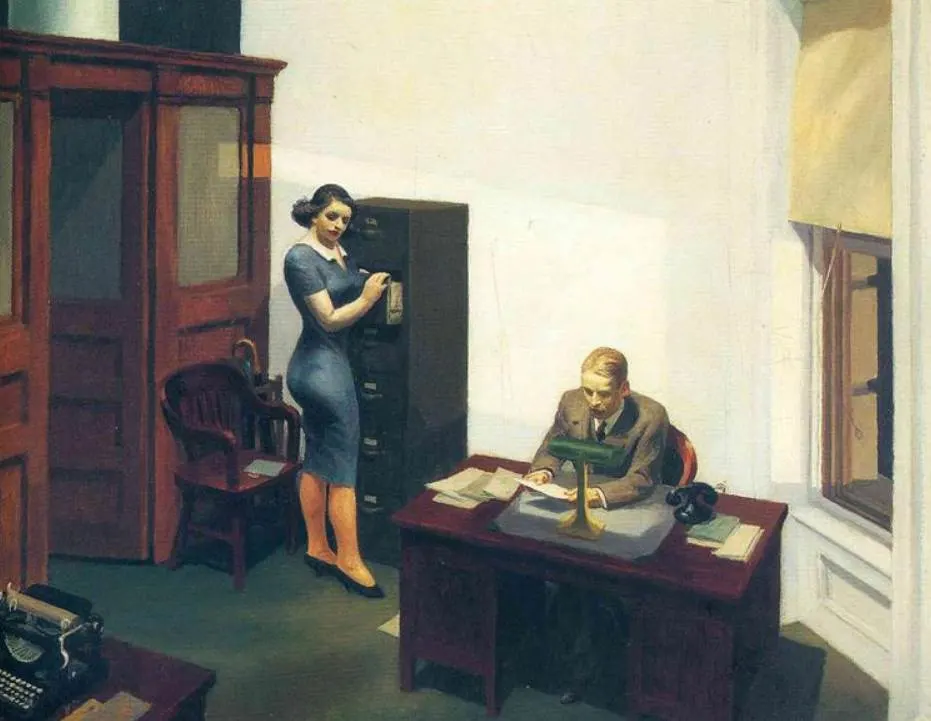
6. Early Sunday Morning
- Date created: 1930
- Dimensions: 89.4 × 153 centimeters (35.2 x 60 inches)
- Location: Whitney Museum, New York City, United States
Early Sunday Morning is a painting that was inspired by businesses and shops located on Seventh Avenue in New York City. It shows a scene that takes place shortly after sunrise and although it’s full of business, the street looks very desolate and abandoned.
Some art critics have suggested that Hopper aimed to portray the desperation in the city shortly after the Wall Street Exchange Crash in 1929 and at the start of the Great Depression. The original title of the painting was “Seventh Avenue Shops” which might hint at this suggestion.
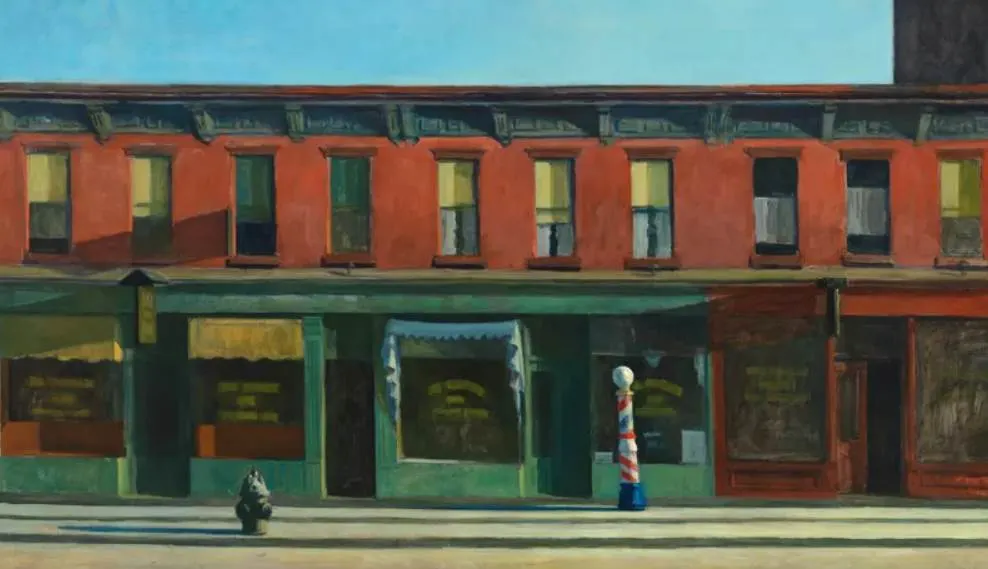
7. Room in New York
- Date created: 1932
- Dimensions: 73.5 x 91.5 centimeters (32 x 24 inches)
- Location: Sheldon Museum of Art, Lincoln, United States
Room in New York is another painting that was inspired by the man rides Hopper took on New York’s L Train. This painting makes it even clearer that we are peaking inside the apartment of a couple in Ne York City because the artist included the window that we are staring through.
Some rooms of apartments were brightly lit during these train rides which allowed anybody to see the interior. The window is extremely dark which contrasts with the brightly illuminated room. The people inside are reading and are focused on their own thing, another way that Hopper’s highlighted the loneliness of people living in the big city.
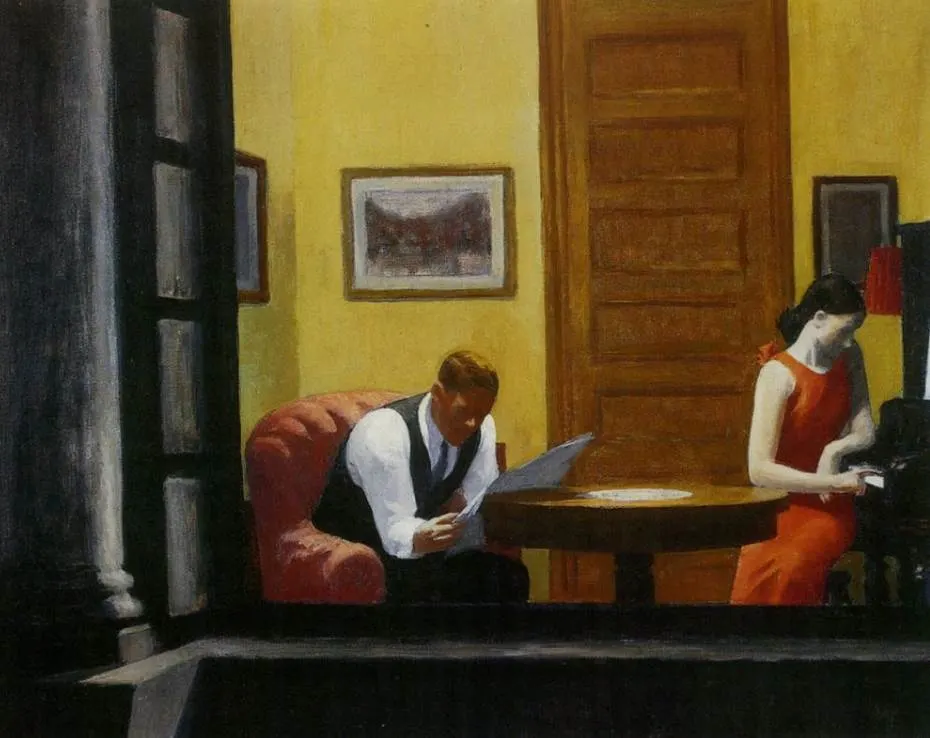
8. Rooms By The Sea
- Date created: 1951
- Dimensions: 74.3 × 101.6 centimeters (29.25 × 40 inches)
- Location: Yale University Art Gallery, New Haven, United States
Rooms By The Sea is a painting that was completed during the final phase of the artist’s career. It was inspired by the many Summer holidays that he took at Cape Cod, Massachusetts, a place where he constructed a studio that overlooked the sea.
Although it might be inspired by the actual view that the artist had from his studio’s window, it’s an abstract and borderline Surrealist work of art that has a deeper meaning. The subject of introspection and loneliness again comes to mind. Hopper himself titled the work “The Jumping Off Place.”

9. Office in a Small City
- Date created: 1953
- Dimensions: 71 × 102 centimeters (28 x 40 inches)
- Location: MET Museum, New York City, United States
Office in a Small City is a painting completed just 2 years after Rooms by the Sea and features a very similar composition. This work depicts an office clerk who is looking out of the window of his corner office. He sees the urban landscape of a small town.
Especially the concrete wall is a prominent element of the view and it’s therefore that his wife Josephine referred to this work as “the man in the concrete wall.” The subtle hint at loneliness and isolation are depicted more enjoyably than in most of his urban paintings.
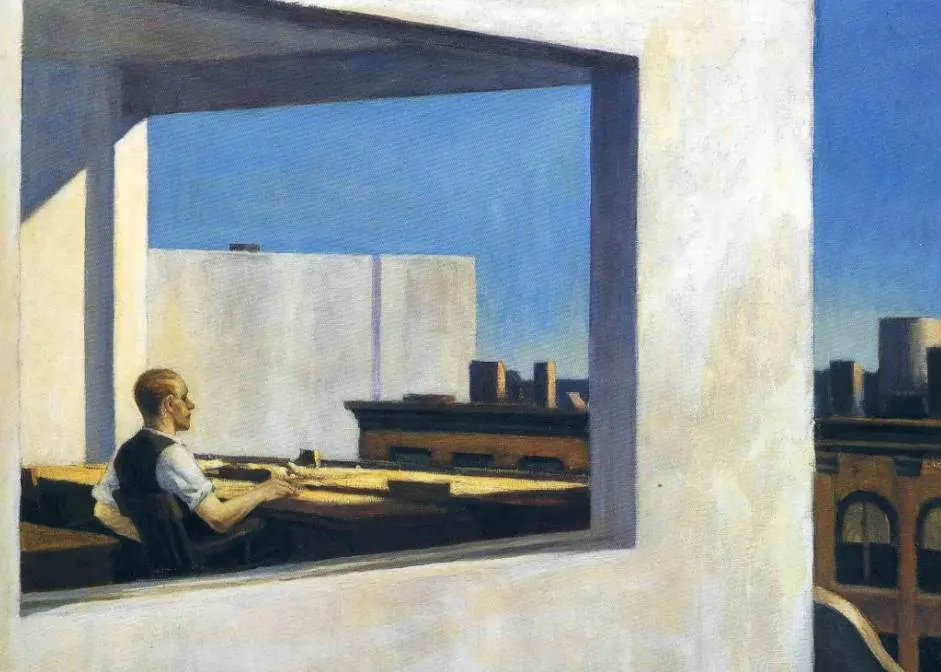
10. Ground Swell
- Date created: 1939
- Dimensions: 91.92 × 127.16 centimeters (36.19 × 50.06 inches)
- Location: National Gallery of Art, Washington, D.C., United States
Ground Swell is a painting that depicts 5 people in a small catboat as their small vessel is pushed upward by a light swell. There’s a dark buoy right next to their boat which is in sheer contrast to the light blue color of the water and seemingly endless sky.
The composition of the painting looks similar to those of Winslow Homer’s painting titled “Breezing Up (A Fair Wind)” (1873–1876) and Thomas Eakins’ painting titled “Starting after Rail” (1874). It’s one of the many paintings that Hopper produce in his studio in Truro, Massachusetts during one of his Summer holidays.
